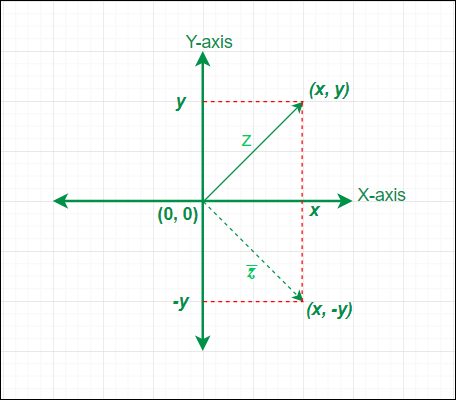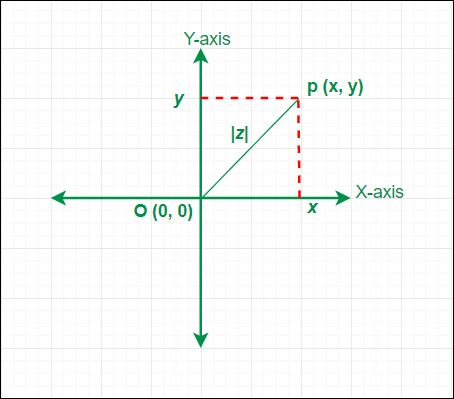复数是以(x + i y)形式表示的数字;其中x&y是实数,而i =√(-1)称为iota(虚数单位)。它也被称为虚数或数量。复数可以是纯实数,也可以是纯虚数,具体取决于x和y的值。
例子:
(5 + 3 i), (0 + 7 i), (-4 + 9 i), (1 + 0 i), (0 – i), etc.
现在,我们将讨论复数的两个非常重要的概念,即共轭和模数。
复数的共轭
复数的共轭数是另一个复数,其实部Re(z)相等,而虚部Im(z)大小相等但符号相反。有时,复数的共轭也称为复共轭。复数z的共轭表示为![]() 和(z&
和(z& ![]() )一起称为复共轭对,因为z和
)一起称为复共轭对,因为z和![]() 是彼此共轭的。如果z =(x + iy)是复数,则z的共轭定义为
是彼此共轭的。如果z =(x + iy)是复数,则z的共轭定义为![]() =(x – iy)。从z与
=(x – iy)。从z与![]() ,我们可以说,复数的共轭是通过用(-i)代替i来获得的。复数共轭的几何意义
,我们可以说,复数的共轭是通过用(-i)代替i来获得的。复数共轭的几何意义![]() 是复数z在复平面或argand平面中围绕实轴(X轴)的反射或镜像。
是复数z在复平面或argand平面中围绕实轴(X轴)的反射或镜像。

在Argand Plane中复数的共轭
共轭物的性质
如果z,z 1和&z 2是复数,则它们将具有以下共轭性质。
- Conjugate of a purely real complex number is the number itself (z =
 ) i.e. conjugate of (7 + 0 i) = (7 – 0 i) = 7
) i.e. conjugate of (7 + 0 i) = (7 – 0 i) = 7 - Conjugate of a purely imaginary complex number is negative of that number (z +
 = 0) i.e. conjugate of (0 -7 i) = (0 + 7 i) = 7 i
= 0) i.e. conjugate of (0 -7 i) = (0 + 7 i) = 7 i  = z
= z- z +
 = 2 Re(z)
= 2 Re(z) - z –
 = 2 i . Im(z)
= 2 i . Im(z) - z
 = {Re(z)}2 + {Im(z)}2
= {Re(z)}2 + {Im(z)}2  =
= 
 =
= 
 =
= 
- z = (z1 / z2) then
 =
=  /
/  ; z2 ≠ 0
; z2 ≠ 0
Note: In order to find out the conjugate of a complex number that complex number must be in its standard form that is Z = (x + i y). If the complex number is not in its standard form then it has to be converted into its standard form before finding its complex conjugate.
例子
例1:如果z =(5 + 7 i)是复数,则其共轭由下式给出:
解决方案:
![]() = (5 – 7 i).
= (5 – 7 i).
例2:如果z = 1 /(4 + 3 i)是复数,则其共轭为
解决方案:
First z has to be converted into its standard form by multiplying the numerator and
denominator with the conjugate of (4 + 3 i)
z = (1 / (4 + 3 i)) × ((4 – 3 i) / (4 – 3 i))
z = (4 – 3 i) / (16 + 9)
z = (4 / 25) – (3 / 25) i
The conjugate of z is ![]() = (4 / 25) + (3 / 25) i
= (4 / 25) + (3 / 25) i
例3:如果(a + ib)是一个复数,它是(8 – 3 i)的复共轭,则a和b的值由下式给出:
解决方案:
Let z = a + i b
![]() = (8 + 3 i)
= (8 + 3 i)
z = ![]()
z = (8 + 3 i)
Two complex numbers are equal only when their corresponding real & imaginary parts are equal
Equating the real and imaginary parts of z & (8 + 3 i)
Re(z) = a = 8
Im(z) = b = 3
Hence 8 & 3 are the respective values of a and b.
复数的模数
复数z =(x + iy)的模数定义为| z |。 =√(x 2 + y 2 );其中x = Re(z)和y = Im(z)。 | z |对于所有复数,≥0。我们无法比较两个复数z 1和z 2,即(z 1 > z 2 )或(z 1 ![]() =√((x – 0) 2 +(y – 0) 2 )=√(x 2 + y 2 )。
=√((x – 0) 2 +(y – 0) 2 )=√(x 2 + y 2 )。

Argand平面上复数的模
模量的性质
如果z,z 1 ,z 2和z n是复数,则它们将具有以下模量特性。
- If a complex number z has equal real and imaginary parts then its modulus is zero i.e. Re(z) = Im(z) ⇒ |z| = 0
- Real and imaginary part of a complex number z always lies between -|z| and |z| i.e. -|z| ≤ Re(z) ≤ |z| and -|z| ≤ Im(z) ≤ |z|
- |z| = |
 | = |-z|
| = |-z|  = |z|2
= |z|2- |Z₁ . Z₂ …….. Zn| = |Z₁| . |Z₂| …….. |Zn|
- |Z₁ / Z₂| = |Z₁| / |Z₂| ; Z₂ ≠ 0
- |Z₁ + Z₂|2 = |Z₁|2 + |Z₂|2 + 2 Re(
 )
) - |Z₁ – Z₂|2 = |Z₁|2 + |Z₂|2 – 2 Re(
 )
) - |Z₁ + Z₂|2 + |Z₁ – Z₂|2 = 2( |Z₁|2 + |Z₂|2)
- |b. Z₁ + a. Z₂|2 + |a. Z₁ – b. Z₂|2 = (a2 + b2) ( |Z₁|2 + |Z₂|2) ; here a & b are real numbers.
Note: To find out the modulus of a complex number that complex number must be in its standard form that is Z = (x + i y). If the complex number is not in its standard form then it has to be converted into its standard form before finding its modulus.
例子
示例1:如果(8 + 3 i)是复数,则其模数为
解决方案:
|8 + 3 i| = √(82 + 32)
|8 + 3 i| = √(64 + 9)
|8 + 3 i| = √(73)
示例2:如果(3 + 4 i) 和(√3+√6i) 如果是两个复数,则其乘积的模数由其各个模数的乘积给出。
解决方案:
|3 + 4 i| = √(32 + 42)
|3 + 4 i| = √(9 + 16)
|3 + 4 i| = √(25) = 5
|√3 + √6 i| = √((√3)2 + (√6)2)
|√3 + √6 i| = √(3 + 6)
|√3 + √6 i| = √9 =3
|(3 + 4 i).(√3 + √6 i)| = 5 × 3
|(3 + 4 i).(√3 + √6 i)| = 15
例3:如果z =(2。i)/(3 – 4 i)是复数,则其模量为
解决方案:
First z has to be converted into its standard form by multiplying the numerator and
denominator with the conjugate of (3 – 4 i)
z = ((2.i) / (3 – 4 i)) × ((3 + 4 i) / (3 + 4 i))
z = (8 + 6 i) / (9 + 16)
z = (8 + 6 i) / 25
z = (8 / 25) + (6 / 25) i
The modulus of z is |z| = √((8 / 25)2 + (6 / 25)2)
|z| = √((64 + 36) /625)
|z| = √(100 /625)
|z| = 10 / 25
|z| = 2 / 5